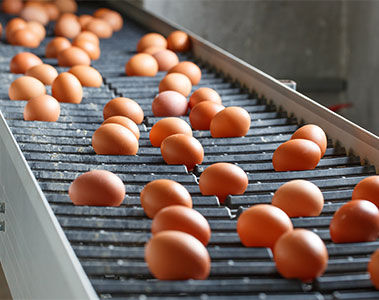
-
Global/EN
- Global
- North America
- Latin America
A golden yolk invariably comes from a healthy hen. This fact is known to consumers, farmers and feed producers alike, and that is why – in most countries – a deep yellow-orange hue is traditionally associated with premium egg quality. The compounds responsible for the color of the egg yolk and skin of chickens are carotenoids, of which more than 700 different varieties exist in nature.(1) However, only five of these are used in commercial poultry production (Table 1). Carotenoids are fat-soluble compounds and are classified into red and yellow, depending on their wavelength or hue. A combination of yellow and red carotenoids is necessary to obtain the proper orange hue that is preferred by consumers. For specific recommendations, please see the DSM Yolk Pigmentation Guidelines.
For egg production to be successful and cost-effective, careful consideration should be given to all the factors involved in the pigmentation process. These include oil quality, carotenoid inclusion level, gut health, age, feed intake, vitamin levels, and proper biosecurity measures. All these different factors have to be carefully managed in order to put a bright-colored egg yolk on the table of the consumer, no easy task, considering that numerous sources of extracted and manufactured carotenoids are available.
One of the most important factors to consider is the source of the carotenoids and influence of that source on effectiveness, stability, color, digestibility, rate of transfer and deposition rate in animal target tissues. Since poultry cannot synthesize carotenoids de novo, the right type and combination of carotenoids have to be delivered via the feed in order to obtain the desired egg color and maintain its uniformity. Not all carotenoids are deposited at the same rate in the target organs . For instance, the standard for red carotenoids is canthaxanthin, with a deposition rate in egg yolk of 2.25 ppm for every ppm of the carotenoid in the feed.(2) Canthaxanthin also has additional positive effects on egg mass(2) and egg yolk quality.(3) By contrast, citranaxanthin, another red carotenoid, is deposited in egg yolk at a rate of 54% below the canthaxanthin deposition value.(4) This may be attributable to the differences in color hue, since citranaxanthin is redder than canthaxanthin. The DSM recommendation equates 1.5 g of citranaxanthin with 1 g of canthaxanthin. Moreover, citranaxanthin is not used for chicken skin pigmentation.
The carotenoids capsanthin and capsorubin are two different carotenoids found in paprika in differing amounts and proportions, and may be chemically extracted and combined with one another to create a commercial carotenoid product for yolk pigmentation. They are redder in color than canthaxanthin. However, the low deposition rate and high variability of the product makes it only 16–40% as effective as canthaxanthin.(5) The current DSM recommendation for yolk pigmentation equates 2.5 g of capsanthin/capsorubin with 1 g of canthaxanthin. For chicken pigmentation, canthaxanthin is used in combination with yellow carotenoids at rates below 10 ppm to give the orange color that is called for in the market. For practical reasons, paprika extracts are not recommended for the pigmentation of chicken skin, due to the off color (spots) they create.
For yellow carotenoids in yolk pigmentation, apo-ester is the most effective and widely used carotenoid. The yolk deposition of apo-ester rate has been calculated at 50–55%, depending on the hen strain (6). This compares very favorably with lutein/zeaxanthin in marigold extract at around an equivalency of 3 g of lutein/zeaxanthin for 1 g of apo-ester(6). For chicken skin pigmentation, the equivalency goes from 1.5 to 2 g of lutein/zeaxanthin for 1 g of apo-ester, depending on conditions.
Another very important factor is product stability during the premix/feed processes and storage. For more information, see part II and part III.
Before starting a pigmentation program, therefore, it is important to decide on the target product (egg yolk, chicken skin, tarso or shank) and the carotenoids to use depending on the availability, deposition rate and prices in the market.
Table 1. Important carotenoids in poultry pigmentation | |||
Hue | Molecule | Original | Target tissue |
Red | Canthaxanthin | Synthetic | Egg yolk, chicken skin, tarso or shank |
Citranaxanthin | Synthetic | Egg yolk | |
Capsanthin/Capsorubin | Chemically extracted from paprika | Egg yolk | |
Yellow | Apo-ester | Synthetic | Egg yolk, chicken skin |
Lutein/zeaxanthin | Chemically extracted from marigold | Egg yolk, chicken skin | |
20 June 2021
Fernando Cisneros is the Global Layer Solutions Lead. He holds a PhD (University of Illinois) and a MSc (UNAM, Mexico) on animal nutrition, and a BSc on Veterinary Medicine (U. Metropolitana, Mexico).
Fernando was a researcher (INIFAP) and then was hired by Roche Vitamins as technical manager in Mexico and Canada, account and sales manager for dsm-firmenich Canada, before his current global role. He is passionate about egg quality, bright food and the sustainability of animal farming.
Murtala is an animal nutritionist. He holds a Ph.D. obtained at François Rabelais University, Tours, France.
Murtala is a dedicated poultry nutritionist and specialized in layer hen nutrition and egg quality. He is the Global lead scientist in different innovation projects to develop new enzymes, carotenoids and tools such as the digital Yolk Fan.
We detected that you are visitng this page from United States. Therefore we are redirecting you to the localized version.